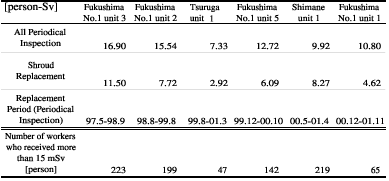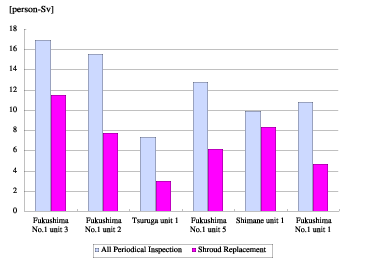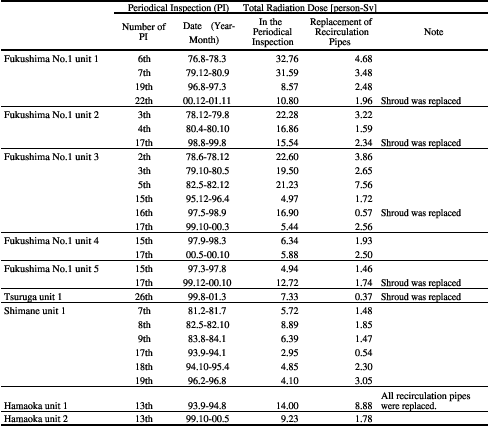|
Workers' Radiation Exposure from Replacing Reactor Core Shroud and Recirculation System Pipes
This article reports on the levels to which utility workers exposed from the replacement of reactor core shroud and recirculation system pipes based on the data that was made public by the request from Diet members (all the information sources are derived from "periodical inspection report" by the Agency for Nuclear Industry and Safety, ANIS).
No Effective Prevention Measures: radiation exposure from the core shroud replacement
The shroud replacement was performed following six reactors (arranged in the order of implementation): Fukushima No.1 unit 3, Fukushima No.1 unit 2, Tsuruga unit 1, Fukushima No.1 unit 5, Shimane unit 1, Fukushima No.1 unit 1.
The total collective radiation dose of workers who were involved in the replacement procedure is shown in the table 1 and figure 1 (unit is "person-sievert," person-Sv). It should be pointed out that the core shroud replacement had a large share among the total dose. It is characterized as a high level of individual worker's radiation exposure who exceeds 15 millisievert (mSv) per year, because it inevitably involve workers operating inside a reactor core. The self-running welding machine is used when a shroud is newly installed. However, the attachment of machine guide inside the pressure vessel requires operation by workers and the same is true for the Jet Pumps installment right inner wall of the reactor vessel.
The breakdown of radiation dose in the case of Fukushima No.1 unit 3 is as followings (unit is millisievert, mSv): shroud replacement (0.8), Jet Pump replacement (4.6), feed-water sparger and reactor core spray replacement (0.1), nozzle safe-end replacement (1.3), additional procedures such as secondary cutting of shroud, chemical decontamination, and installing shield wall inside reactor pressure vessel (4.7). It has been known that the installment procedure of Jet Pumps involves the highest radiation exposure to workers, because they are located near the reactor vessel wall. That is why the total radiation dose at Tsuruga unit 1, which has not Jet Pumps, is relatively small as compared to other cases.
From the same data, the dose rate of 3.3mSv per hour is recorded inside the core of reactor vessel. We have not obtained the data for other 5 reactors yet. In the Journal of Atomic Energy Society of Japan, September 2002, following several technical modifications at the Simane unit 1 were reported: material used for a shield wall was changed from lead to tungsten and chemical decontamination was repeated inside of a pressure vessel. Even such measures were adapted, however, the fact that utility workers are forced to expose high level of radiation dose still remains as a substantive issue.
No Data is Available for the Replacement of Recirculation System Pipes
The workers' radiation dose received from the replacement procedure of recirculation System Pipes were summarized in the table 2. Regrettably, this table is far from complete. ANIS has refused to disclose the actual data by saying that the agency does not administer such data. In the case of repairing reactor's internal components, the Electric Utilities Law defines that electric power company should submit the relevant data when it plans to conduct repairing work which concerns the strength and performance of laying pipes. If the pipe's material and dimensions (thickness and its caliber) are the same as the original pipes, they are eligible for the exception of data submission to the agency and, therefore, no data is available based on the law.
Let us introduce the example of Shimane unit 1. According to the attached document No. 8 of the "comprehensive inspection report regarding the appropriate maintenance for the voluntary inspection procedure" (which was accessible at the Chugoku Electric Power Co.'s homepage on March 18, 2003) , there are no data available for the 22th periodical inspection despite the fact that the replacement of recirculation pipes were conducted throughout four periodical inspections (17th, 18th, 19th, and 22th).
According to the report "evaluation of nuclear power facilities' equipment" released on March 2003 from the ANIS, the inspection of welded-joint portion of recirculation pipes, workers were exposed to radiation dose around 300 to 400 person-mSv, the three quarter of which were from the header and riser pipe portion. Although the high level of radiation exposure would be expected from the replacement work at the connection parts to the riser pipe of Jet Pump which was located most closely to reactor vessel in the 22th periodical inspection of Shimane unit 1's, ANIS did not monitor the relevant data and, therefore, data is not available for public.
It has been pointed out that the length and depth of cracks found in recirculation system pipes, by conducting an ultralsonic wave test (UT), were actually underestimated; suggesting the UT cannot measure cracks with precision.
There is no doubt that the accuracy of measuring length and depth of cracks in the reactor shroud by employing UT would not be improved without understanding the actual working condition.
Chihiro Kamisawa (CNIC staff)
Table 1: Nuclear Workers Radiation Exposure from the Periodical Inspections including Shroud Replacement

Figure 1: Nuclear Workers Radiation Exposure from the Periodical Inspections including Shroud Replacement

Table 2: Situation on Workers' Radiation Exposure from the Periodical Inspection

Return to NIT 96 Contents
|

